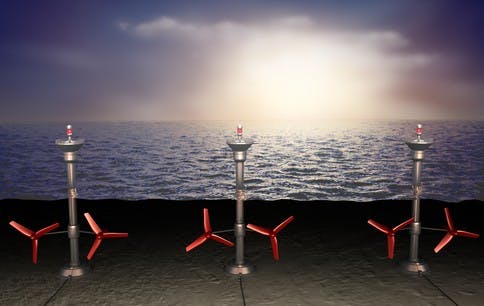Mark Hamilton, managing director at Scotrenewables Tidal Power has 10 years engineering, management and commercial experience in the tidal industry. As an expert in marine renewable energy, he has driven the growth of a tidal energy start-up business into a company with £20 million worth of valued business.
Scotrenewables is a member organisation dedicated to strengthening business relationships and committed to securing the best possible environment for the growth of renewable energy in Scotland.
Its aim is to harness Scotland’s abundant natural resources to secure a future that will deliver on jobs, investment, energy security and climate change.
Ahead of the upcoming International Tidal Energy Summit, Hamilton speaks to Tidal Today’s project director Will Broad about the potential of tidal energy and what lessons Scotland’s tidal industry can offer to the rest of the world.
How does the tidal power opportunity in the UK compare to that of Europe and abroad? Does the UK government do enough to incentivise the development of commercial tidal projects?
It has been shown in numerous studies that the UK has a vast tidal resource that has the potential to supply a significant percentage of the country’s electricity demand. Therefore, a tremendous opportunity exists.
The UK government has encouraged the harnessing of this resource by providing grant funding for test devices and commercial prototypes. Scotrenewables Tidal Power have been supported throughout our turbine development process by the Scottish Government in the form of grant funding to develop our SR250 250 kW prototype and SR2000 2MW commercial demonstrator respectively. This funding has been vital to the company and has allowed us to leverage significant international private investment.
The financial incentives provided to demonstrator and commercial tidal energy projects under the Renewables Obligation and under the proposed Contracts for Difference Scheme have been encouraging to our investors. It strikes a good balance between providing sufficient support at this early stage in the industry, while not resulting in unacceptable surcharges on domestic electricity bills.The Renewables Obligation is a renewable power incentivisation scheme, while Contracts for Difference refers to long-term contracts to provide stable and predictable incentives for companies to invest in low-carbon energy generation.
Significant challenges exist, however, in terms of delays to grid connection upgrades in the north and west of Scotland, where much of the tidal resource in the UK exists and high transmission charges on the Scottish Islands. We are encouraged by the announcement by the UK government that a higher strike price - the price that the government will pay for renewable power under the contract for difference scheme - is likely for the ‘Scottish Islands’ as this may go someway to off-setting the high transmission charges incurred here and we await details of this proposal with anticipation.
What impact do you envisage the Electricity Market Reforms having? Once these are established, will the industry see a noticeable increase towards commercial projects?
The adoption of the Electricity Market Reforms, a bill introduced by the UK government to cope with the rising demand for energy, and the financial incentives incorporated into them, allow a benchmark to be set in terms of the required cost of energy for the industry to work towards.
The industry will undergo a period of appraisal as to what devices currently under development have the potential to produce the required investment returns under the financial incentives proposed.
Following this appraisal, it is likely that there will be an increase in commercial project development due to the increased financial certainties the Energy Market Reform brings.
However, there is likely to be a refocus on the tidal technologies that will be installed at these sites as many of the technologies currently under development are unlikely to be capable of meeting the required cost-of-energy targets and the required reduction in the cost of energy generation as the incentive levels are reduced in line with offshore wind.

What do you see as the biggest challenge in making tidal energy cost competitive?
Cost reductions are required in all keys areas; manufacture, deployment, operation and maintenance in order for large tidal energy arrays to be cost competitive.
While many companies will be able to make cost reductions through further refinements of the devices themselves as research and testing continues, the greatest challenge lies in reducing costs in maintenance and deployment of these devices.
Many of the devices currently being tested use vessels that have been built for use in the offshore oil and gas industries which, through the energy density of fossil fuels, can afford such expensive vessels. Such devices, due to their inherent design concept will struggle to disentangle themselves from the use of these large (and prohibitively expensive) vessels during the future installation, maintenance and decommissioning of these devices in commercial projects.
Only technologies that can achieve this transition such as the Scotrenewables Tidal Turbine, whose design rationale was always based around the use of smaller, less expensive, multi-cat vessels, will achieve the required life cycle cost of energy to allow financially viable commercial tidal arrays.
How do you envisage tidal projects being financed in the future?
“
Before debt financing can occur, investor confidence in the tiday industry much be developed… The industry must also develop formalised methods of resource and risk assessment, and reduce uncertainty in general
In the longer term, tidal energy projects are likely to be financed in a similar way to other renewable energy developments such as onshore wind, through a combination of equity and debt finance.
Before debt financing can occur, investor confidence in the industry much be developed. The Energy Market Reform adoption will assist in this. The industry must also develop formalised methods of resource and risk assessment, and reduce uncertainty in general so as to compare with the benchmark set by the onshore wind energy industry.
In the shorter term, equity investment alongside government investment funds, such as the Renewable Energy Investment Fund (REIF) administered by Scotland’s economic agency Scottish Enterprise will play an important role in financing demonstrator arrays. These demonstrator arrays will in turn provide the learning opportunities that will help build the confidence required to normalise financing of the industry.
What does the next 10 years hold for the tidal industry?
The draft strike prices for tidal energy developments in the UK set a challenging but achievable target that will require further technology development and innovation in all aspects of the lifecycle cost of projects.
It is possible that many tidal devices, due to their inherent design concept will be unable to achieve the required cost of energy target to make a sufficient return on investment at these incentive levels. Therefore, there are likely to be a significantly smaller number of devices remaining in the market in ten years, with specific niches depending on the development site’s characteristics, for example, ground conditions, water depth, etc.
Most of the large tidal energy developments in the UK require significant grid connection upgrades in order for them to connect. These upgrades are likely to be in place in the next few years and the pace of development will, to a significant extent, depend on how quickly these upgrades can be established.
Small demonstrator sites will start to connect over the next five years, large scale deployment is likely within about 10 years.
It is unclear at this stage as to the likely pace of development in other countries with significant tidal resources, such as France, Canada and the United States. Much will depend on the research and development and commercial incentives offered.
To hear more from Mark Hamilton and other speakers on the global tidal energy industry, please register for the 7th Annual International Tidal Energy Summit.
Located at Victoria Park Plaza, London, on the November 26-27 2003, the International Tidal Energy Summit is the largest and most comprehensive commercial networking forum dedicated to the global tidal energy industry.
With attendance from all the CEOs of major device developers and representation from the major industrial investors, this is a unique opportunity to connect with over 350 executives changing the face of the tidal energy industry.


















